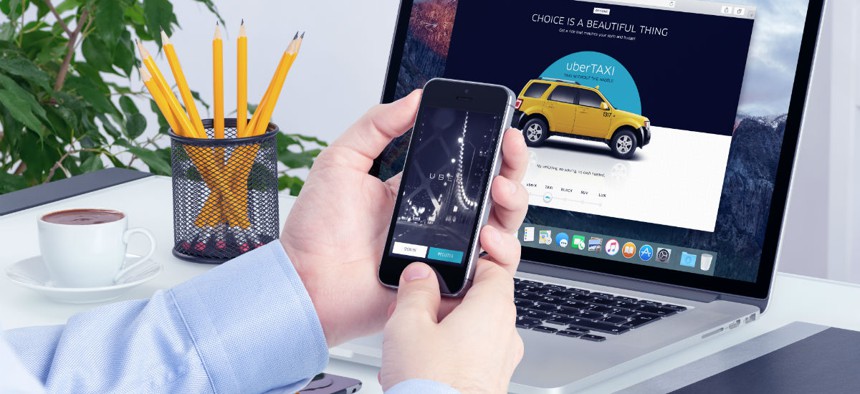What Can the Postal Service Learn from Uber?

Alexey Boldin/Shutterstock.com
The Office of the Inspector general suggested apps for mobile payment, and for scanning packages and paying for their pickup.
The Postal Service’s Office of the Inspector General wants the agency to take cues from Uber's and Starbucks' mobile apps.
USPS has offered its mobile app, USPS Mobile, since 2009, and it now has about 7.2 million downloads. USPS Mobile has a variety of functions, including Post Office location, package pickup scheduling and package tracking. But in a new report on mobile technology, inspectors pushed the agency to upgrade the app to take advantage of unique smartphone features, such as camera functionality and GPS tracking instead of simply adapting USPS' regular Web services to a mobile format. OIG recommended USPS adopt a “mobile-first” campaign in which mobile technology is the "focal point of developing ways to engage with consumers."
For instance, Starbucks' app, which lets customers pay by scanning their smartphones at the register, is "easy to use," and it's "equally critical for the Postal Service to ensure its apps are easy to use and integrate well with the smartphone’s features," the report said.
Startups like ride-sharing service Uber and lodging-sharing site Airbnb "that are able to make consumers’ lives easier ... are more likely to find success."
USPS’ OIG has been pushing the agency to upgrade its technology, often looking to the private sector for ideas. Earlier this month, the office urged USPS to consider using the "Internet of Things," a connected network of devices and sensors to set up digital mailboxes and self-monitoring delivery vehicles, among other applications.
In the report on mobile technology, OIG pitched several ideas for five new USPS mobile apps:
- Scan and Send would allow a user to scan an item to ship, order a box for that item, get the box delivered, schedule a home pick-up and pay for postage;
- Passport Control, an app to help customers make appointments for passport services and auto-fill passport forms;
- Mobile Bill Pay, a payment platform on which users could scan paper bills, and make payments accordingly;
- Money Orders, an app through which customers could send orders, save information about frequent recipients, and speed up the in-person process. (Money orders generated $165 million for USPS in 2014, the report noted);
- Coupon Collection, to help customers store and organize coupons they receive in the mail. (This used to be included in the USPS Mobile app but was removed due to "technological limitations," the report said. But with the improvement of phone cameras, Coupon Collection "could be a viable opportunity at this time.")
OIG also suggested a few features that could be added to the USPS Mobile app, including:
- A system allowing customers to import mail-to address from their address book contacts, and auto-filling forms with recently used information
- Sending package recipients a text when a package is sent to them, letting them arrange a pickup time and location, and offering faster delivery for a fee
- Letting users track wait times at Post Offices, so customers can avoid long lines. (Analysis of social media posts about the Post Office shows that its customer service is generally viewed negatively, the report said. Only 1.6 percent of social media posts suggested positive customer experience, especially because of long wait times, the report said.)
But not all mobile apps have worked out for USPS, OIG noted. Last year, the Postal Service released an "augmented reality" app that made its traditional blue mailboxes appear to be animated when users scanned them with their smartphone cameras.
Though the app was "applauded by many tech writers for using new technology in a campaign," the users themselves were "not pleased," the report said -- many called the app "buggy" and slow to load, giving it a 2.5 out of 5-star rating in the app store.
(Image via Alexey Boldin/ Shutterstock.com)
NEXT STORY: FAA has looked at clouds from both sides now





